Dive Details
Location
Date
Saturday 30 March 2019
Time
2:28pm - 4:09pm
Buddy
Sheree Rose
Seas
Strong surge at times
Visibility
2 to 8 metres
Duration
101 minutes
Surface interval
Maximum depth
21.6 m
Average depth
15.4 m
Water temperature
18.1°C
Dive Profile from Citizen Hyper Aqualand

Tides at Botany Bay AEDT
Note that tides at dive site may vary from above location.
High
4:58am
1.48m
Low
11:52am
0.62m
High
5:59pm
1.22m
Low
11:29pm
0.77m
Details
Sheree joined me for today's dive at The Leap. It had been nearly 3 weeks since my last full dive at The Leap. I'd dived with Georgia last Sunday but we skipped most of the Field of Pygmies looking for Weedy Seadragons and the dive before that with Graham we straight to Southern Cross Roc. Today we'd visit the Field of Pygmies and I'd be able to check on my pygmy pipehorses.
There was a north-easterly swell but it wasn't affecting The Steps and didn't look all that bad at The Leap. In fact, I was able to get in safely from the low platform. We swam out on the surface before descending. We started swimming at around 60° but Sheree went ahead and veered to the right, a lot, so that she was almost heading back to shore. I had to call her to head back out to the sand line. We arrived between the wall and the amphitheatre not far from Pygmy Rock. The visibility was between 5 and 8 metres but at it looked quite dark when the clouds covered the Sun. The water temperature was around 19°C. The current was quite strong and there was quite a bit of surge. I found out later that I missed a Weedy Seadragon as we descended to the sand line. We turned left and headed towards The Steps.
We swam past Pygmy Rock and on to the first rock in the Field of Pygmies where I know there are pygmies. The rock and much of the area was surrounded by kelp. I looked for the original pair of pygmy pipehorses. I couldn't find them. They weren't near the yellow sponge nor the area I first saw them. The area I'd first seen them back in November last year was quite bare. At the other end of the rock I spotted the other male (IL2018110301) in his usual spot next to the orange sponge. The female (IL2018110302) was to the left. I pointed them out to Sheree who pointed out a small (~4cm) reaper cuttlefish just near them.

Male Sydney Pygmy Pipehorse, Idiotropiscis lumnitzeri, (IL2018110301). 20.8m.
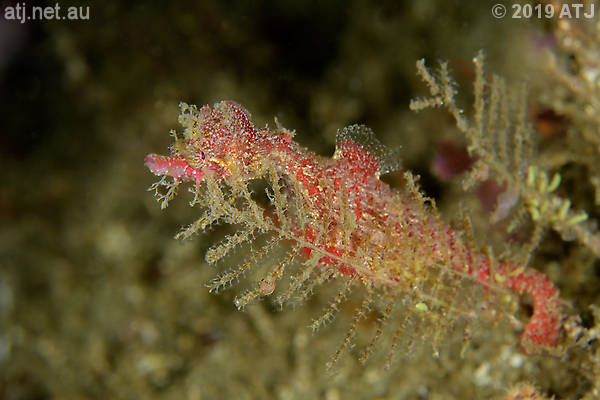
Male Sydney Pygmy Pipehorse, Idiotropiscis lumnitzeri, (IL2018110301). 20.9m.
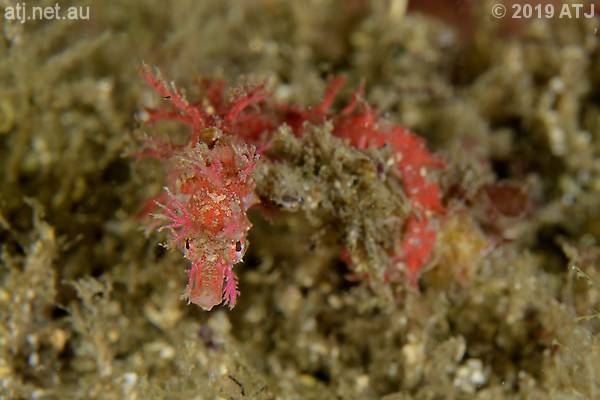
Female Sydney Pygmy Pipehorse, Idiotropiscis lumnitzeri, (IL2018110302). 20.9m.
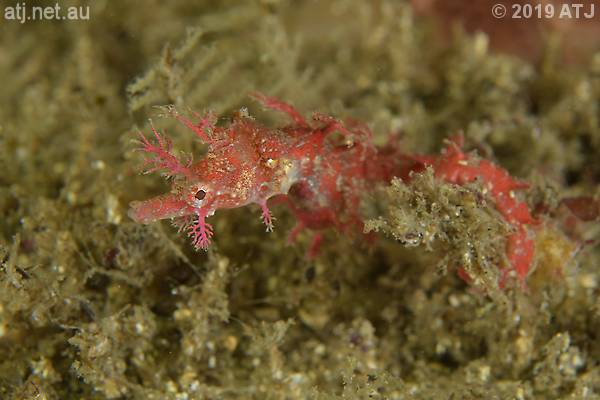
Female Sydney Pygmy Pipehorse, Idiotropiscis lumnitzeri, (IL2018110302). 20.9m.
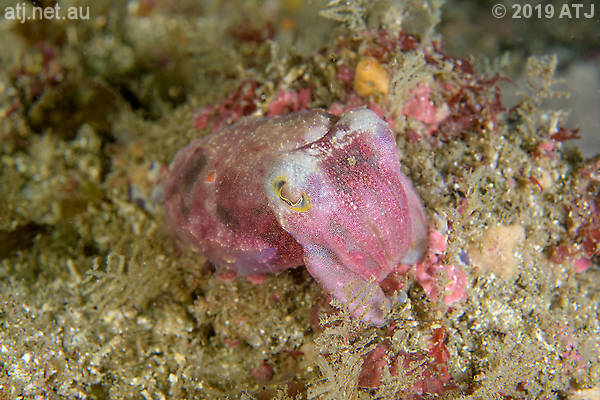
Reaper cuttlefish, Sepia mestus. 20.8m.
I headed to the slightly higher rock closer to the shore to look for the pair of pygmies I have been seeing on that rock. I looked where I'd last seen them but could not find them. I looked along the end of the rock and still couldn't find them. The surge made it difficult to look.
I headed to the large flat rock with sponges to look for the pair I've seen there. I found the male (IL2019022801) I'd first seen a month ago. I then found a female (IL2019033001) who appears to be new.
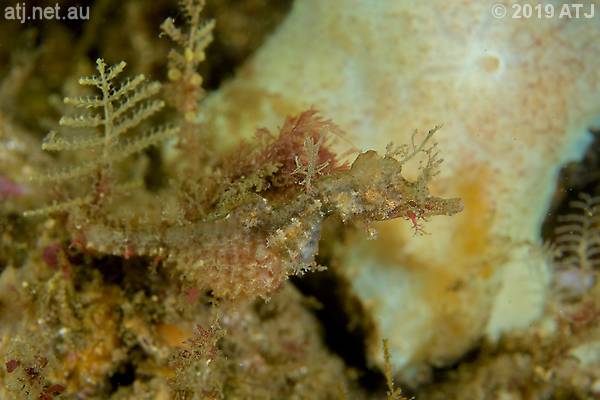
Male Sydney Pygmy Pipehorse, Idiotropiscis lumnitzeri, (IL2019022801). 20m.
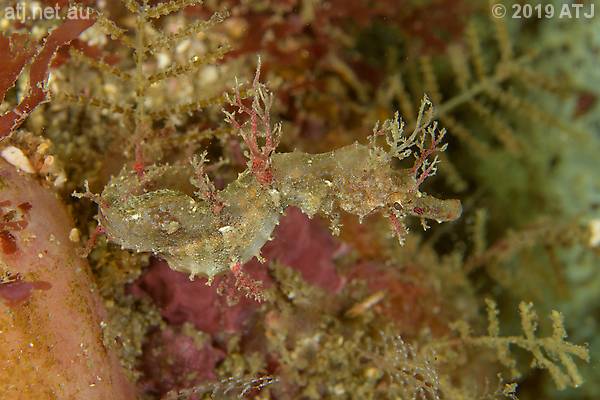
Female Sydney Pygmy Pipehorse, Idiotropiscis lumnitzeri, (IL2019033001). 19.7m.
Sheree had spotted a Weedy Seadragon near the first rock so I swam over to her. It was a male and he had the last remnants of eggs. I thought how late it was in the breeding season for him to have had his eggs and was sorry I hadn't seen him while he still had his eggs.
We swam on. I had a quick look on the rock before Bob & Lucy Rock for the pygmies that were there and also a brief look on Bob & Lucy Rock. I looked on one of the rocks adjacent to Bob & Lucy Rock and spotted a male pygmy pipehorse (IL2019033002). It was not one of the ones I'd seen on that rock previously.
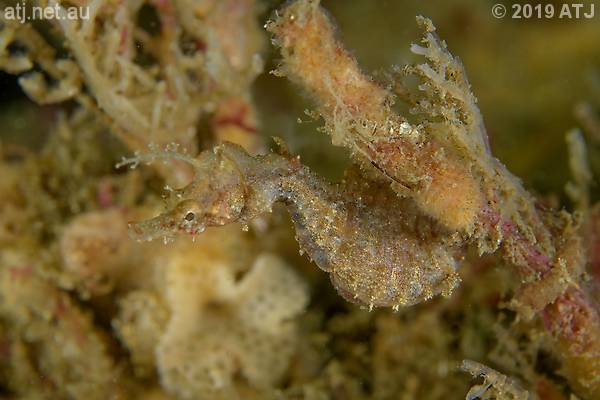
Male Sydney Pygmy Pipehorse, Idiotropiscis lumnitzeri, (IL2019033002). 20.6m.
Sheree spotted another Weedy Seadragon. It was "Clyde". I don't see him as often as I used to but this was the second dive in a row that I'd seen him. A little farther along I spotted a female weedy.
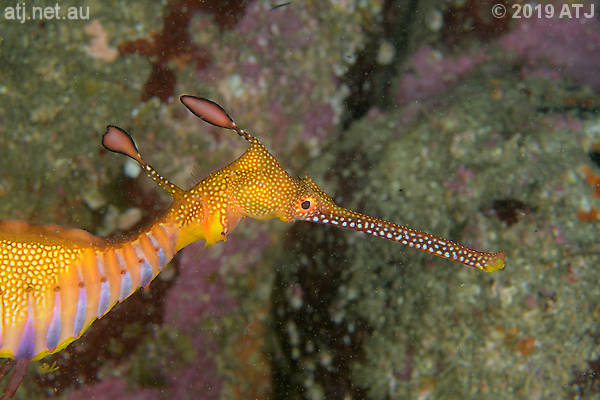
Weedy seadragon, Phyllopteryx taeniolatus, ("Clyde"). 20.8m.
We stopped at Ian's Pygmy Rock and I looked for the pygmies there. I have been seeing two pairs there of late although I couldn't find any last Monday. I wasn't able to find any today. I need to have a more thorough look when the conditions are a little better.
We swam past Seahorse Rock and on towards the low flat rocks with sponges. On the sand before the rocks we spotted three Weedy Seadragons: the female, the male that had three broods over the breeding season and another male. The male that had three broods has a hole in his flank.

Weedy Seadragon, Phyllopteryx taeniolatus. 20.8m.
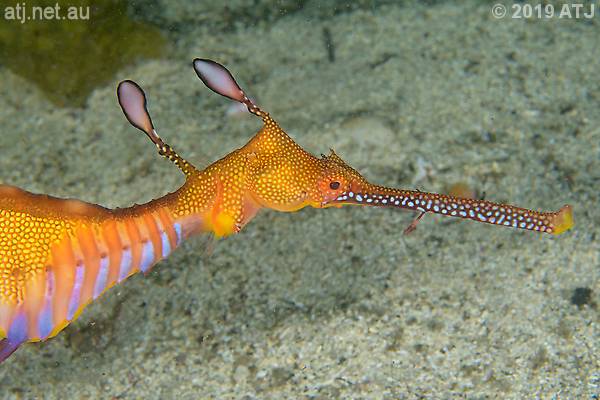
Weedy Seadragon, Phyllopteryx taeniolatus. 20.3m.
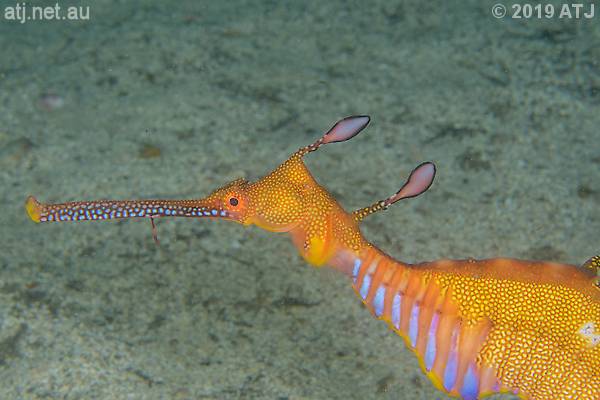
Weedy Seadragon, Phyllopteryx taeniolatus. 20.3m.
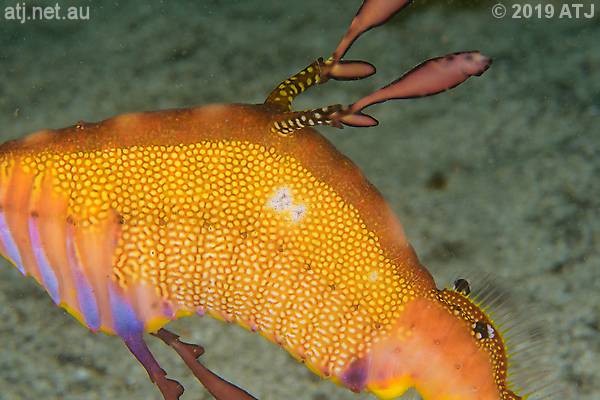
Weedy Seadragon, Phyllopteryx taeniolatus. 20.3m.
I headed up to the spot where the pygmy pipehorses are on the next rock past the overhang. I spotted the juvenile female (IL2019032401) I first saw last Sunday. I then spotted the newish male. I then looked for the other pair and found them both. The surge made photography very difficult.
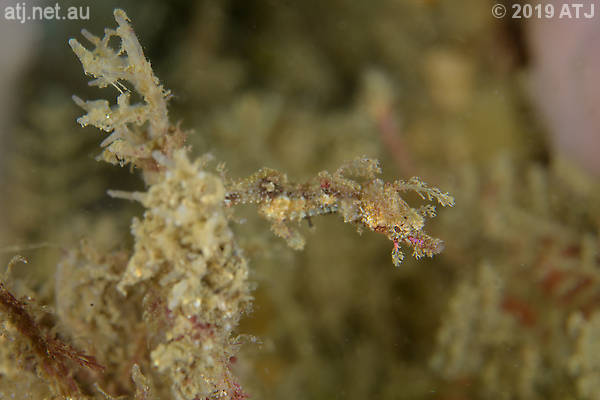
Juvenile Sydney Pygmy Pipehorse, Idiotropiscis lumnitzeri, (IL2019032401). 17.9m.
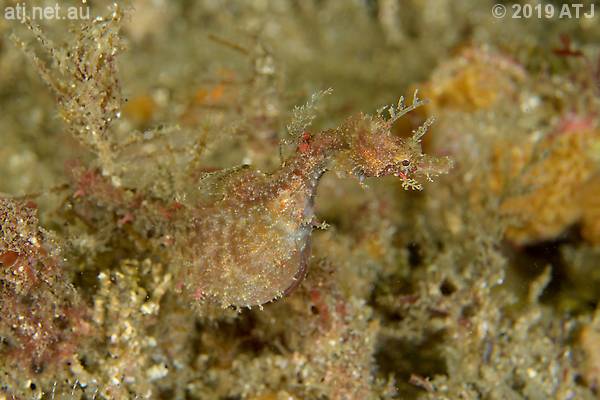
Male Sydney Pygmy Pipehorse, Idiotropiscis lumnitzeri. 17.6m.

Female Sydney Pygmy Pipehorse, Idiotropiscis lumnitzeri. 18.7m.
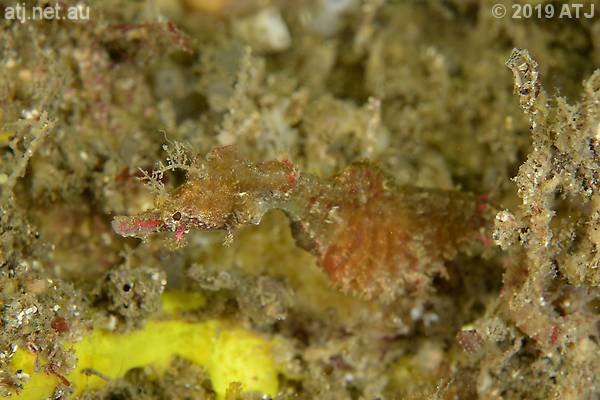
Male Sydney Pygmy Pipehorse, Idiotropiscis lumnitzeri. 18.5m.
I swam along the sand line and Sheree a but higher up towards Southern Cross Rock. Sheree stopped on at one of the rocks before Southern Cross Rock and spotted a pygmy pipehorse. As she pointed it out we saw another and then another. That was pretty good spotting.
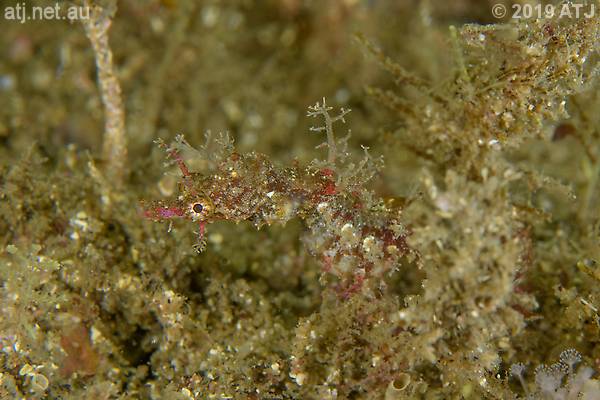
Female Sydney Pygmy Pipehorse, Idiotropiscis lumnitzeri. 17.6m.
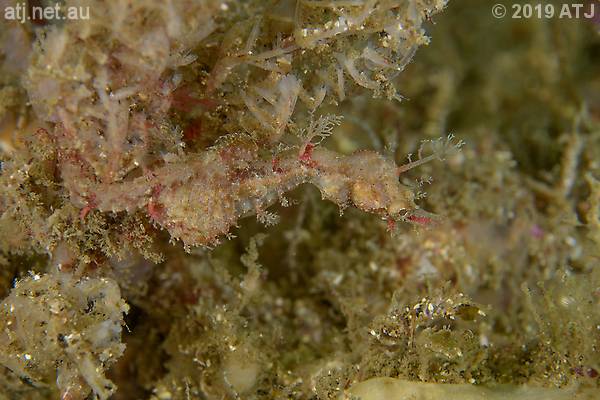
Male Sydney Pygmy Pipehorse, Idiotropiscis lumnitzeri. 17.5m.
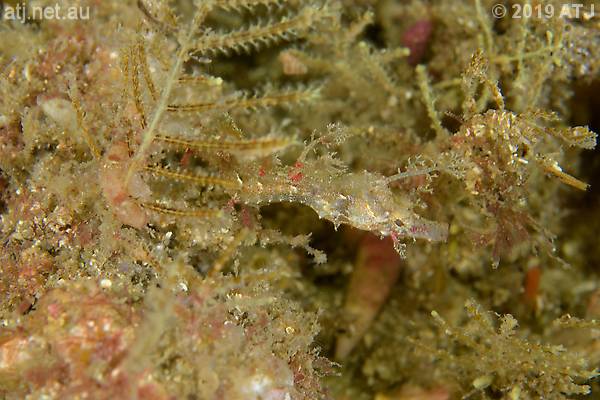
Juvenile Sydney Pygmy Pipehorse, Idiotropiscis lumnitzeri. 17.6m.
We continued past Southern Cross Rock and on into Seadragon Alley. Sheree spotted a smallish Weedy Seadragon. It may have been one of the juveniles from last year.
We followed the sand line to just before Big Rock. The visibility had dropped to below 5 metres. We swam up above Big Rock to the rock where George's orange Red-fingered Anglerfish as been. I looked around the whole rock, above and below but was not able to find it.
I headed down to Big Rock to look for the pygmy pipehorses near the sea tulips. I found the male but was not able to find the female. I headed over to Hand Rock to look for the pygmy there. I looked where I'd seen it on Monday but it wasn't there. I then spotted a male on the other side of the sponge and then a female at the other end of the sponge. Does that mean there have been two this whole time? I pointed them out to Sheree.
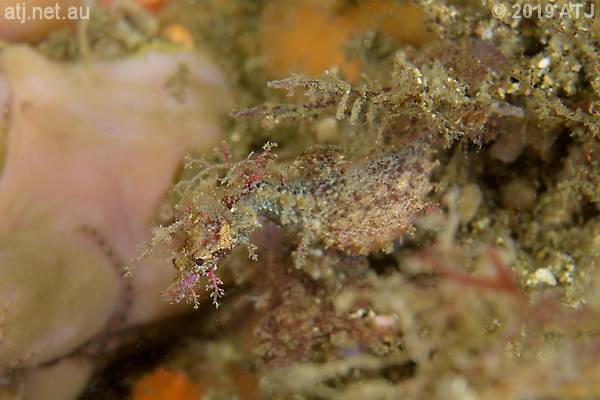
Male Sydney Pygmy Pipehorse, Idiotropiscis lumnitzeri. 13.1m.
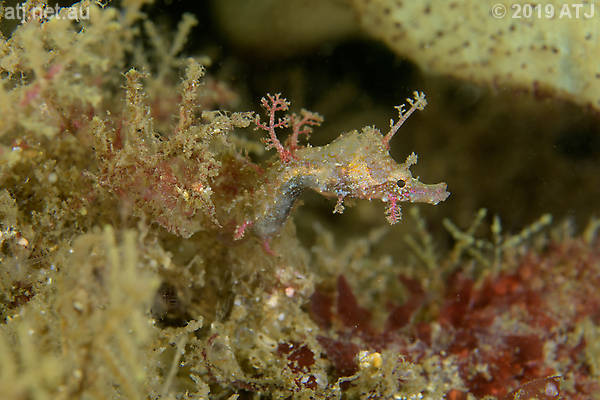
Male Sydney Pygmy Pipehorse, Idiotropiscis lumnitzeri. 13.5m.
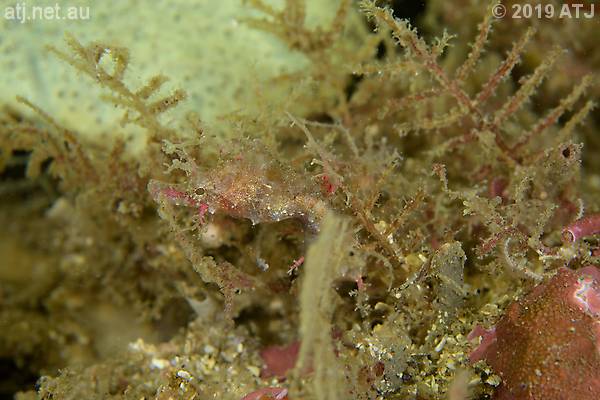
Female Sydney Pygmy Pipehorse, Idiotropiscis lumnitzeri. 13.4m.
We followed the reef towards Diversity Rock. I spotted a male Weedy Seadragon along the way. We looked for the Miamira sinuata nudibranch and white Red-fingered Anglerfish near Diversity Rock but didn't find them. I found an Atagema intecta nudibranch. I swam up to the basket star and then back to Diversity Rock where I spotted the white anglerfish.
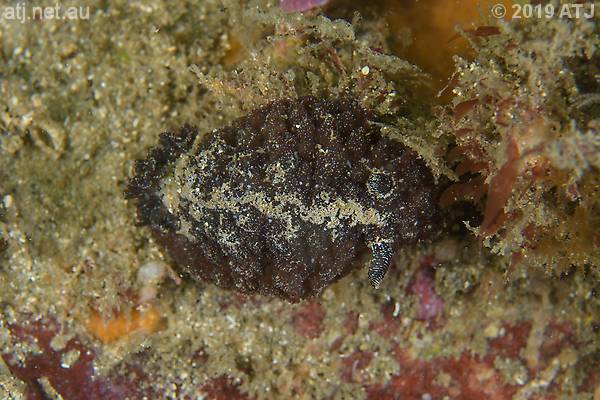
Nudibranch, Atagema intecta. 12.3m.
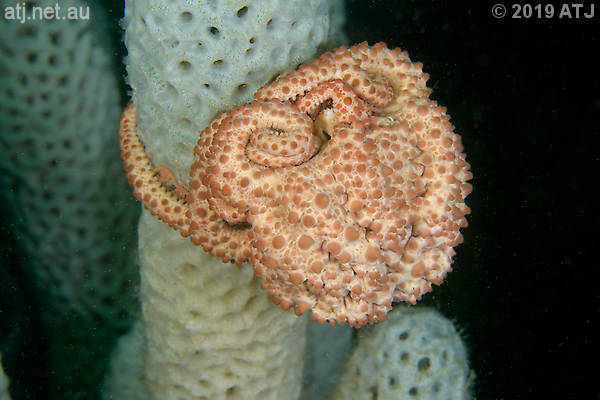
Basket star, Astrosierra amblyconus. 11.7m.

Red-Fingered Anglerfish, Porophryne erythrodactylus. 13.1m.
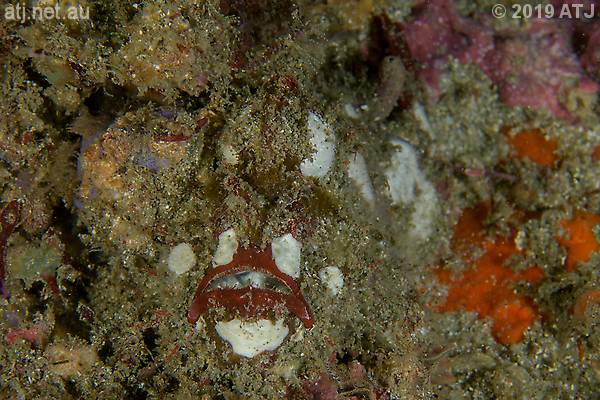
Red-Fingered Anglerfish, Porophryne erythrodactylus. 13.2m.
We continued to Little Big Rock and to the Pot-bellied Seahorses. I spotted "David" first in the sea tulips and then we spotted "Petra" in the lower sea tulips on the lower rock.
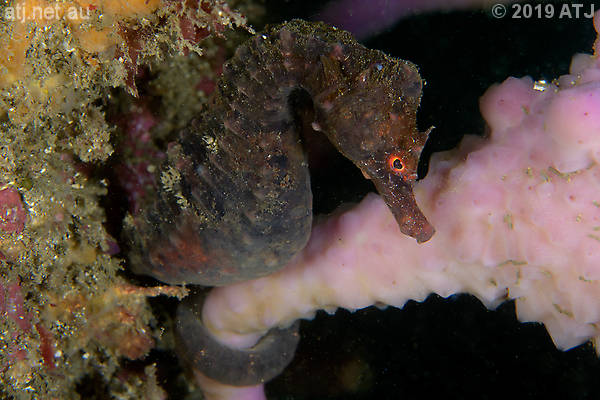
Male Pot-Bellied Seahorse, Hippocampus abdominalis, ("Davd"). 11.5m.
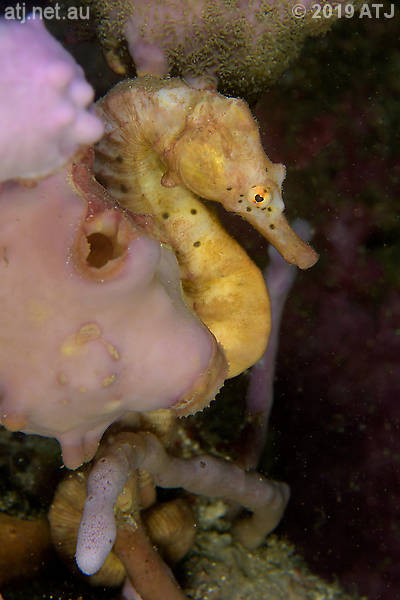
Female Pot-Bellied Seahorse, Hippocampus abdominalis, ("Petra"). 12.1m.
We followed the sand line to the large yellow Red-fingered anglerfish. It was in its usual spot. I took photographs and pointed it out to Sheree.

Red-Fingered Anglerfish, Porophryne erythrodactylus. 12.8m.
We continued along the sand line to where Georgia and I had seen the juvenile Weedy Seadragon on Sunday. It was still there. I took some photographs.
We swam up to Di's Rock and on to the rock where the large orange Red-Fingered Anglerfish has been. It was still hanging out under the side of the rock. I took some photographs and pointed it out to Sheree.
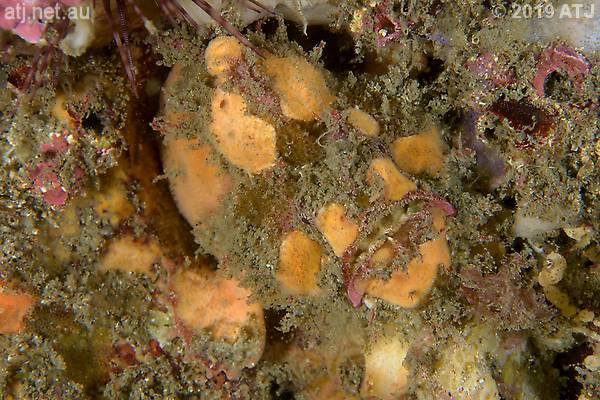
Red-Fingered Anglerfish, Porophryne erythrodactylus. 11.1m.
We continued along the reef until we were in line with the rock where the other Pot-bellied Seahorses used to be. The visibility had dropped quite a bit by now and so it was a little difficult to find the rock where I saw the small orange Red-fingered Anglerfish last weekend. I found the rock but could not see the anglerfish.
We headed to the boulders and ascended to 5 metres triggering our safety stop. We finished the safety stop at Split Rock and then swam underwater to the exit. The exit was quite easy.
Camera gear
Camera
Nikon D500
Lens
Nikon AF-S Micro Nikkor 60mm f/2.8G ED
Housing
Ikelite 6812.5
Lens port
Ikelite Flat Port 5502.41
Strobe
2 x Ikelite SubStrobe DS161